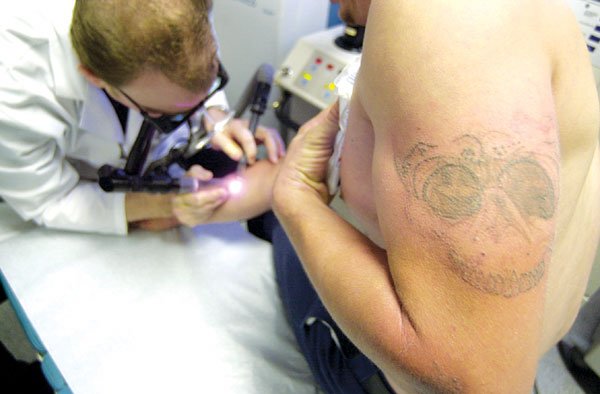Christopher grasps the bench tightly, hugging its vinyl surface
as if for dear life while a laser clicks in the quiet exam room. A
few moments from now, his third treatment will be over, but for the
time being, with a painful zap focusing on his skin 10 times a
second, he grits his teeth.
Christopher grasps the bench tightly, hugging its vinyl surface as if for dear life while a laser clicks in the quiet exam room. A few moments from now, his third treatment will be over, but for the time being, with a painful zap focusing on his skin 10 times a second, he grits his teeth.
“Pain? No, this feels great,” he jokes as with each pulse comes the feeling of a rubber band being snapped across his skin.
The young man, who wished to have his last name withheld, is here to remove the initials tattooed above his shoulder blades. He’ll leave the Aztec calendar that covers the rest of his back in place.
“I got it a couple of years ago because I wanted to show my Mexican heritage, but now I want to become a firefighter,” said the 20-year-old. “Visible tattoos are an absolute no.”
While they still carry a certain level of stigma, one in seven Americans has a tattoo, according to a 2003 joint survey by the Scripps Howard News Service and Ohio University. Moreover, one in three college students has body art, a statistic three times the level seen in Baby Boomers. More than 90 percent of them will eventually regret their choice, according to Dr. Bruce Saal, a dermatologist in San Jose and an expert in tattoo removal. A search did not turn up any place offering the service in the South Valley area.
Saal began offering laser tattoo removal in 1977 and has since removed more than 25,000 inkings, making him a leader in the industry.
“Really, when you think about it, what article of jewelry do you have that goes with everything, that you want to wear all the time and that you’ll never tire of?” asked Saal. “Life is long, and the decision you’re making is going to stick with you. Then again, no one ever accused young people of making clear decisions.”
Rodney Copus thought getting a tattoo was cool when he was a teen – so cool, in fact, that he ended up with 16 of them.
“It was just dumb kid stuff,” said the 31-year-old tire serviceman, who previously sported tattoos of eagles, skulls and roses. He is now undergoing treatment to remove nine of the most visible marks from his hands, forearms and biceps. “When I got older, I realized that they just weren’t professional.”
The treatment hurts more than the tattoos’ original application, said Copus, but even with the pain and the out-of-pocket price of $75 to $350 per visit, it’s worth it.
“In the moment, it hurts,” said Copus, but things feel better by the next day and he enjoys the results as, by his 15th treatment, many of the tattoos have faded significantly.
The process works by accelerating the body’s own response to the tattoo: Attack! When ink is originally applied, it becomes suspended in the collagen layer between a person’s skin and fat layers. The body, sensing this foreign invader, sends white blood cells to attack, carrying off ink to the nearest lymph node for closer inspection. The process doesn’t stop entirely, but as your immune system becomes accustomed to the dye’s presence the attack slows in progression.
Laser treatments focus their beams on the specific color of dye underneath the skin, shattering the particles and causing the body to attack with renewed vigor. Unfortunately, there is no set timetable for this. Doctors cannot be sure what is underneath the skin because there is almost no regulation of the tattoo industry.
“Someone could tattoo you with mascara and it would be legal,” said Saal. “There aren’t any sanitation standards to speak of. Basically, all someone needs is a business license.”
The type of pigment, density and depth of application all play a role in how quickly a tattoo fades. Copus said his matching forearm eagles (done by different tattoo parlors) are fading at differing rates, and Saal noted that treatments can number as few as three and as many as 50. The good news is that today’s laser technology is non-scarring.
“The average tattoo is going to have most of the fading happen in the first six or eight weeks,” said Saal. After that, he works on them until the skin looks as if nothing had ever touched it.
“There are colors that are hard to deal with,” said Saal. “Purple, brown, pink, light blues, limey greens are all things where we don’t really have a laser for.
“We have lasers for black and red and green inks, but the others are tricky.”
Black ink is generally the easiest to destroy, while green is tricky. The “problem colors” mentioned above may end up needing to be burned off after their fading, and unfortunate pigment choices like the use of graphite as a tattooing agent can be impossible to reverse, though rarely is that the case.
“We want patients to preferably not get the tattoo,” said Saal. “Life is challenging enough. But if they do, it isn’t something they have to have forever. Stand in front of a mirror and picture that tattoo. Picture yourself in a tuxedo, in a wedding dress, in a bathing suit … does it really fit?”
Even the process of removing nine tattoos hasn’t completely sealed off the prospect of fresh ink for Copus.
“I’d probably get another tattoo, but I’d think a lot about what it was and where I put it before getting it done,” he said.
To schedule an appointment with Saal, call (408) 374-1320. He and his staff will be opening an additional practice in Gilroy on March 1.















